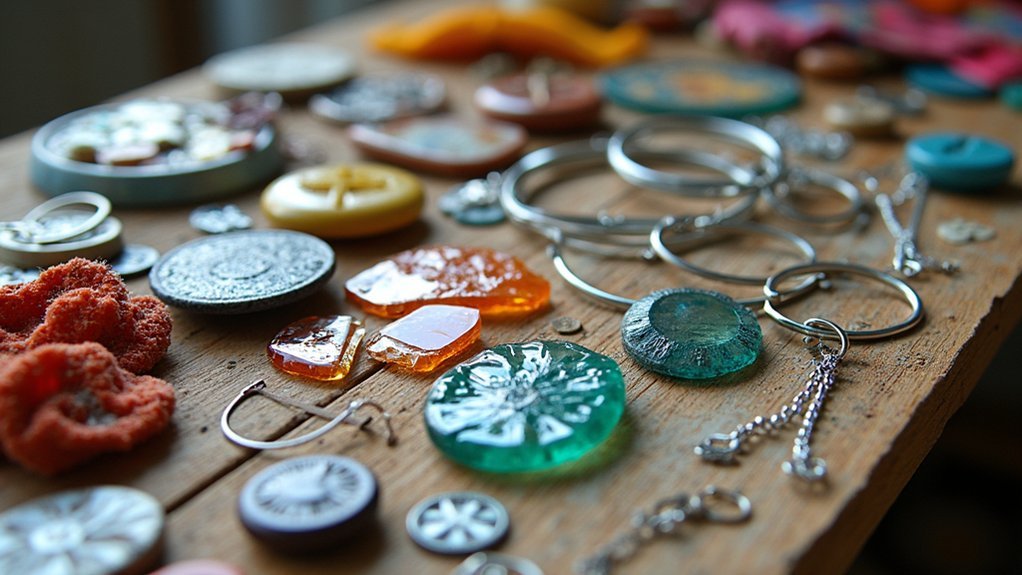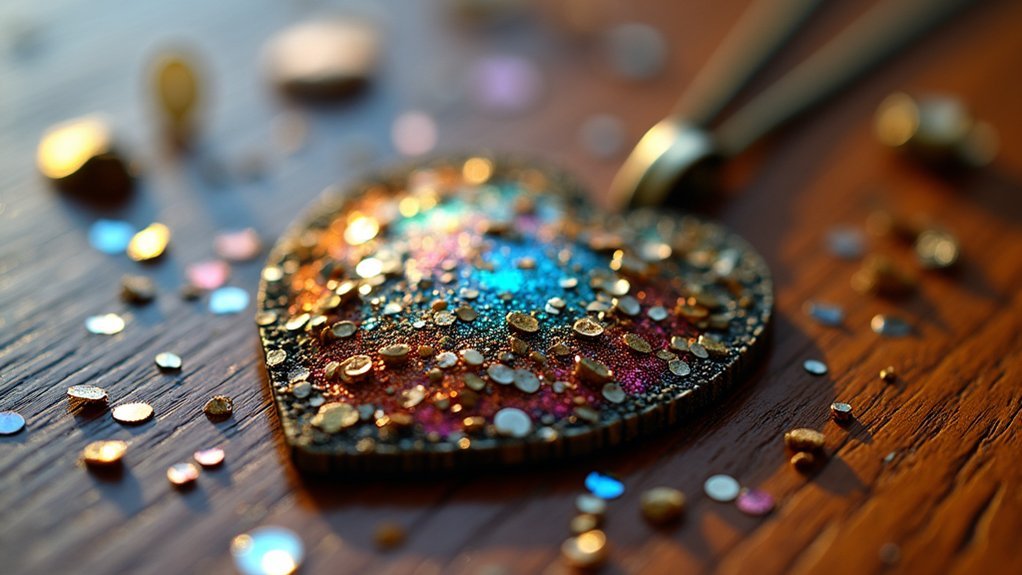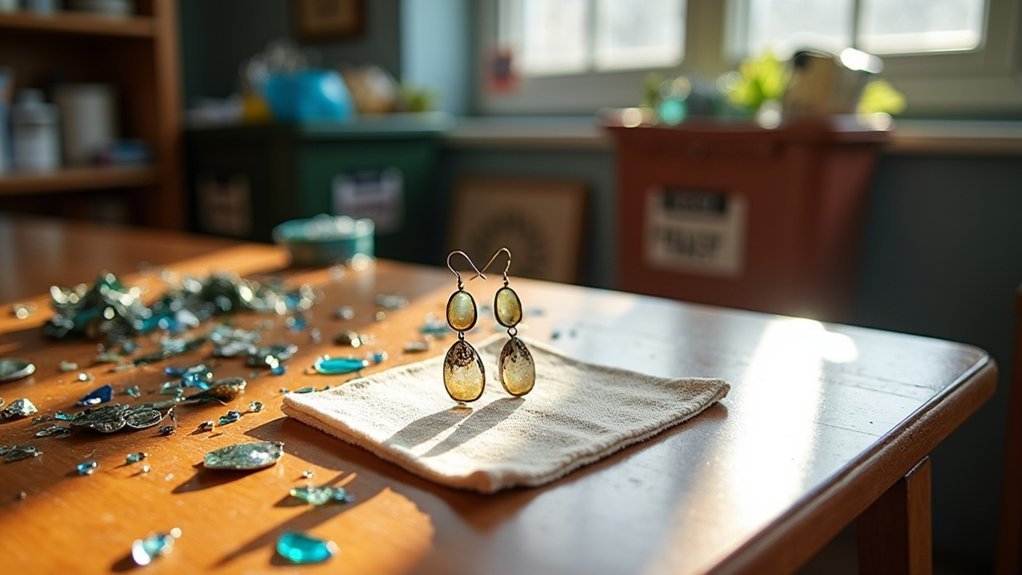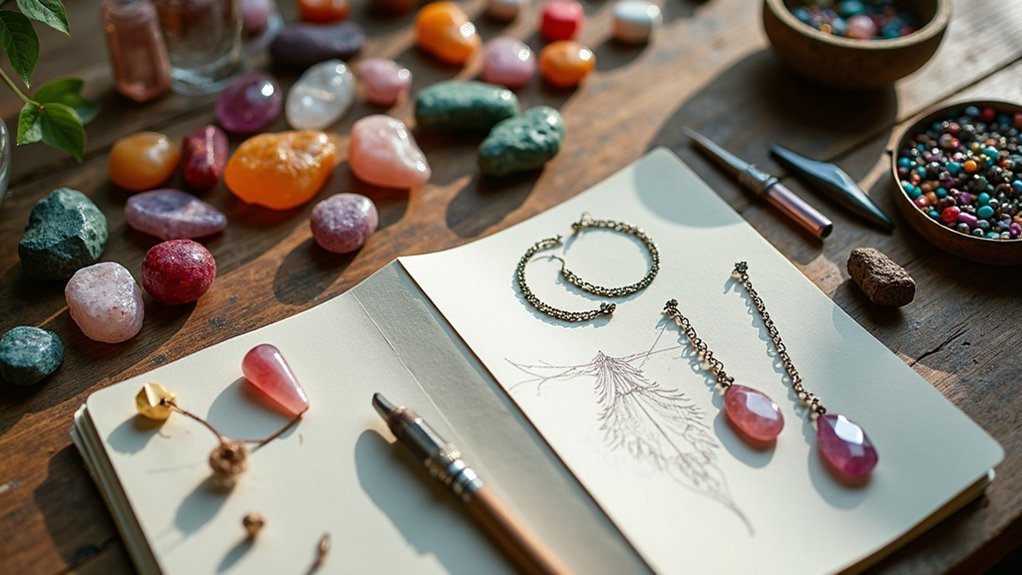You’ve probably noticed how much material gets wasted in traditional jewelry making—those metal shavings, cut-off ends, and design mistakes that seem inevitable. But what if you could transform your entire creative process into one that produces virtually no waste? The shift toward zero-waste jewelry design isn’t just about being environmentally conscious; it’s about maximizing your materials, reducing costs, and discovering innovative techniques that’ll fundamentally change how you approach each piece.
Choose Recycled and Upcycled Materials for Your Designs

Every year, millions of dollars worth of precious metals end up in landfills when you could transform them into stunning jewelry pieces instead. Approximately $60 million in gold alone gets discarded through used technology annually.
By choosing recycled metals like gold and silver, you’ll dramatically reduce your environmental impact while maintaining quality. These recycled materials require less energy to process than mining new precious metals.
Recycled precious metals deliver the same stunning quality as newly mined materials while drastically cutting environmental impact and energy consumption.
Upcycled materials offer another sustainable approach to zero waste design. Transform vintage jewelry, electronic components, or textile scraps into unique pieces that prevent landfill accumulation.
This circular economy mindset honors past craftsmanship while reducing resource consumption. Your sustainable practices will reduce waste and align with ethical jewelry brands, driving innovation in responsible sourcing throughout the industry.
Master Efficient Cutting and Shaping Techniques to Minimize Scraps
Although selecting sustainable materials forms the foundation of zero waste jewelry design, mastering efficient cutting and shaping techniques will dramatically reduce material waste in your workshop. You’ll want to implement nesting techniques that arrange patterns efficiently on raw material sheets, maximizing material usage while minimizing scraps.
Invest in high-quality cutting tools for precise cuts that generate minimal excess material. Templates and digital design software help optimize layouts and prevent costly miscuts. Don’t forget kerf reduction—accounting for blade thickness guarantees you minimize material lost during cutting.
| Technique | Tool Required | Waste Reduction |
|---|---|---|
| Nesting patterns | Design software | 15-30% |
| Kerf compensation | Precision blades | 5-10% |
| Template cutting | Metal templates | 10-20% |
| Digital layout | CAD software | 20-35% |
| Strategic planning | Measurement tools | 10-25% |
Regularly assess cutting strategies based on material properties to continually improve efficiency.
Repurpose Metal Shavings and Small Remnants Into New Pieces

Even with the most efficient cutting techniques, you’ll still generate metal shavings, filings, and small remnants that shouldn’t go to waste.
Repurposing these materials is essential for sustainable design and minimizing waste in your jewelry-making process. You can collect and melt down approximately 90% of your metal shavings to create new components, effectively establishing a circular economy in your workshop.
This approach reduces your environmental impact while lowering production costs, as recycled metals cost less than newly mined materials.
- Implement a systematic collection process to achieve nearly 100% material reuse for zero-waste production
- Transform remnants into unique pieces that appeal to environmentally conscious consumers
- Combine different metal shavings to create distinctive alloys and textures
- Design exclusive jewelry lines specifically featuring repurposed materials as a selling point
Design Modular Jewelry Components for Maximum Versatility
Modular jewelry components transform how consumers interact with their accessories by creating endless styling possibilities from minimal pieces. You’ll maximize versatility by designing transformable elements like stackable rings or adjustable-length necklaces that encourage investment in fewer high-quality pieces rather than excessive purchases.
| Component Type | Versatility Features | Sustainable Benefits |
|---|---|---|
| Stackable Rings | Multiple combinations possible | Reduces individual ring purchases |
| Convertible Necklaces | Adjustable lengths and styles | Extends product longevity |
| Interchangeable Pendants | Various looks from one chain | Minimizes material waste |
| Modular Earrings | Mix-and-match elements | Promotes customization over consumption |
| Connector Systems | Adapts to fashion trends | Maintains ethical standards |
Incorporating recycled metals into modular jewelry enhances both sustainability and appeal. You’ll foster personal expression through customization while reducing waste, as consumers cherish versatile pieces that adapt to their evolving style preferences rather than discarding outdated accessories.
Implement a Complete Workshop Waste Collection System

Creating beautiful modular jewelry requires a foundation of responsible material management throughout your entire production process.
You’ll dramatically reduce your workshop waste and environmental impact by implementing a thorough waste collection system that prioritizes recycled materials and efficient recycling practices.
Your zero waste approach should include:
- Designated sorting bins for different materials like scrap metal, plastic, and paper to streamline efficient recycling
- Regular weighing and tracking of waste output to monitor resource management progress
- Systematic repurposing tools and materials to encourage upcycling instead of purchasing new supplies
- Clear signage and periodic audits to guarantee proper sorting and identify improvement opportunities
This structured waste collection system transforms discarded materials into valuable resources, supporting your commitment to sustainable jewelry creation while maintaining professional workshop standards.
Frequently Asked Questions
How to Make Eco-Friendly Jewelry?
You’ll create eco-friendly jewelry by using recycled metals like sterling silver, incorporating upcycled components, implementing low-waste casting techniques, sourcing ethical gemstones, and choosing biodegradable packaging for sustainable practices.
What Is the Most Sustainable Metal for Jewelry?
You’ll find recycled gold and silver are the most sustainable jewelry metals. They’re infinitely recyclable without quality loss, eliminate mining’s environmental damage, and reduce carbon emissions by avoiding the need for new extraction.
How Can a Jewelry Brand Be Sustainable?
You can make your jewelry brand sustainable by using 100% recycled metals, upcycling old components, adopting small-batch production, choosing biodegradable packaging, and sourcing materials locally to reduce emissions.
What Is an Example of Sustainable Jewelry?
You’ll find sustainable jewelry in pieces made from 100% recycled sterling silver, which drastically cuts mining needs. Lab-grown diamonds also offer you conflict-free alternatives that avoid traditional mining’s environmental damage.
In Summary
You’ll transform your jewelry-making practice by implementing these five zero-waste strategies. Start by sourcing recycled materials and perfecting your cutting techniques to eliminate unnecessary scraps. Don’t overlook those metal shavings—they’re opportunities for creative new pieces. Design modular components that’ll serve multiple purposes and satisfy customers’ desire for customization. Finally, establish your waste collection system to capture every valuable fragment. You’re not just creating beautiful jewelry; you’re building a sustainable future for your craft.





Leave a Reply